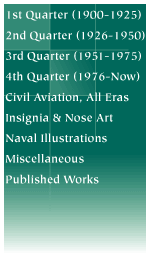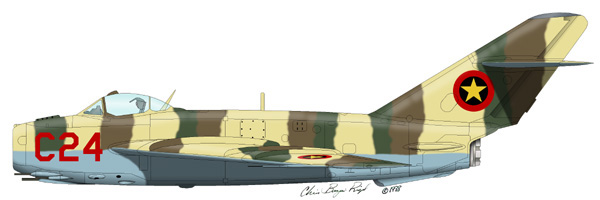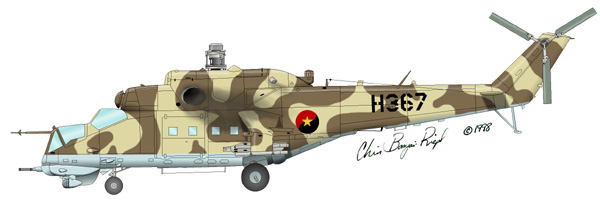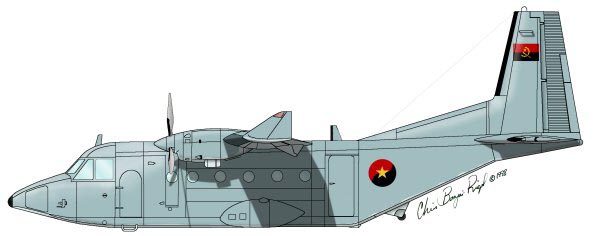
![]()

African Warriors: Angola
By Chris Banyai-Riepl
The air forces of African countries are difficult at best to get accurate information on, and the smaller, communist-based ones are even more difficult. In doing these profiles on Angolan aircraft, I had to do some deep digging to find enough information to make accurate renditions. As it is, the actual colors are best guesses based on the few color pictures I was able to turn up. Angola has had an interesting history in the 20th century, as do most African countries. As the Portuguese were kicked out, many of the leftover aircraft and helicopters found their way into the new Angolan Air Force. The communist leaders of Angola also found help from the Soviet Union, East Germany, and Cuba, with many East German and Cuban mercenaries helping both on the ground and in the air in the war against South Africa. If anyone has more information about this air force, please email me.

Starting off the collection is this MiG-17F. The MiG-17 found its way into quite a few air forces, and was a very nimble airplane. Developed from the MiG-15, Mikoyan Gureyvich increased the performance of the MiG-15 with just airframe improvements, giving us the MiG-17. Ths one is finished in the early style of national markings of a black circle outlined in red with a yellow star centered in it. The camouflage featured a light yellow-brown with dark brown and dark green striping over a blue gray belly. The number reflects the plane type, in this case "C" for Combat.
With South Africa improving its air force with Mirages, Angola increased its capabilities with the MiG-21. This put them more in line with their opponents, but the South Africans were still able to hold their own. This pilot of this particular MiG-21MF got lost and crash-landed in Namibia. Later it was displayed to the public. It sports a two-tone camouflage of light yellow-brown and dark brown over blue gray, and has the current, later roundel style.

The wars in Africa is where the helicopter really shined. The primitive back country makes resupply by ground difficult and sometimes even impossible, but a helicopter can fly in, resupply or even evacuate without difficulty. The Angolans got their first taste of the usefulness of helicopters back when the Portuguese used Alouettes to move troops and act as COIN gunships. When the Soviet Union started to supply weapons, helicopters were at the top of the list and the venerable Mi-8/17 made their way into the air force. This one has a camouflage similar to that of the MiG-17, but its number is in black instead of red.

With the MiG-21, the MiG-23 was added to the air force to give added air-to-air capabilities, as well as to bring in an air-to-ground platform as well. This one features an odd four tone camouflage composed of dark green, medium green, dark brown, and light brown over the normal blue-gray. The dark brown and dark green seem to match the dark brown and dark green found on the Mi-8/17 and MiG-17, but the other two colors don't seem to match anything else. Maybe these planes were originally painted for the eastern European theatre, and the other colors were applied upon reaching Angola.

The success of the Mi-8/17 as a gunship led to the purchase of the much more powerful Mi-24 Hind helicopter. With advanced weaponry and a durability to small arms fire, these gunships fought well in the ground support mission. They all were finished in the same camouflage of light yellow-brown and dark brown, and have a sharp demarcation between the colors. The standard Angolan roundel is on the rear fuselage, and the number is stenciled on the boom in black ("H" for helicopter).

Stepping away from Soviet aircraft, Angola has purchased several CASA C.212 planes for light hauling work. Finished in a low-viz gray scheme, they provide a definite contrast to the browns of the rest of the air force. They also carry the Angolan flag on the tail and the roundel on the fuselage, a change from the standard fixed wing approach.
